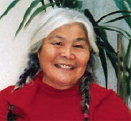Chistochina Ahtna Advanced Reader
Web Version June 2018
Featured Speaker
Lena Charley
Linguistic Transcription
John T. Ritter
Original Illustrations
Susan McCallum
Series Editor
Cynthea L. Ainsworth, Ph. D.
A production of
Mt. Sanford Tribal Consortium
Funded by
Creation and Printing of Series funded by Grant #90NL0299 from the Administration for Native Americans and Grant #S356A030043 from the Alaska Native Education Program of the Department of Education (DOE-ANE). Web conversion funded by Grant #S356A170083 from DOE-ANE.
Chistochina Ahtna Advanced Reader
ISBN 0-9760483-1-0
This title is part of the MSTC Ahtna Language Series
© 2009 Mt. Sanford Tribal Consortium. All Rights Reserved
Mt. Sanford Tribal Consortium
HC01 Box 357
Gakona, AK 99586
www.mstc.org
This book is based on a design developed by
Yukon Native Language Centre, John T. Ritter, Director 1977-2017
YNLC illustrations and photos used by permission
Cover design and sound by Paula Elmes, ImageCraft Publications & Design
Web design and sound conversion by AE Data, Inc
Sound and web function correction by Frostline Productions, LLC
Continuity from print to web version by Alaska History Projects, LLC
Taa’tl’aa Denae
We are the Taa’tl’aa Denae (Headwater People) of Chistochina and Mentasta, located in the eastern-southcentral interior of Alaska. Our culture is rooted in thousands of years of tradition, family, and cooperation. Our villages are inhabited by Ahtna people who were nomadic hunter gatherers. Our ancestors were the last Alaska Native group to see permanent settlement in their territory, established in the winter of 1898–99 during the Klondike Gold Rush into the Copper River Valley. The Upper Ahtna villages of Mentasta and Chistochina continued their seasonal patterns of subsistence travel until 1957, when the first village schools were instituted.
In today’s changing world, our Elders are the last remaining links to these traditions—to who we once were. Elders have a perspective on life that is closely tied to the land, and Athabascan people have always looked to them for advice and guidance.
Foreword
You are using a web representation of a title in the Mt. Sanford Tribal Consortium’s MSTC Ahtna Language Series (2009), which is further discussed in the Introduction. In 2018, the interactive computer CDs that accompanied six in the ten book series were used in conversion to web design. It is hoped that reformatting these important Alaska Native language educational materials will extend the lessons for self-study to learners who make exclusive use of web-access devices other than computers. A stable Internet connection is required to play selections of the voice recordings without delays.
Preface — Lena Charley (1930- )

Lena Charley at Yukon Native Language Centre. (Photo by John Ritter 2003)
Lena Charley grew up in the Twin Lakes and Nabesna Bar area of the Upper Copper and Nabesna River Valleys. When she moved to Chistochina with her husband and children in 1960, she spoke no English. By 1999 Lena was teaching her language in the local school, and she has been a regular teacher at the Summer Culture Camp, where she instructs youth in traditional arts and crafts. In MSTC’s Native Language Program (2004), Lena took her granddaughter, Jessica Denny, as her apprentice in teaching the Chistochina Upper Ahtna dialect. Jessica was the first Upper Ahtna person to complete the YNLC Certificate in Teaching Native Language. In 2006, Lena began working with her grandniece, Honalee Sanford, who was the program’s second apprentice language teacher.
From 2003 to 2011, Lena was a regular visitor to the Yukon Native Language Centre (YNLC) in Whitehorse, Canada, where she shared her knowledge of the Ahtna language as a teacher, mentor, and linguistic consultant. Lena has been the featured speaker for Chistochina in the MSTC Ahtna Language Series.
Introduction
Mt. Sanford Tribal Consortium’s MSTC Ahtna Language Series is the first new, classroom-based language material published for study of the Ahtna language since 1975. MSTC’s first editions (2000) of the Language Lessons in all five dialects were a milestone in materials development for in-school programs and adult independent study of the Ahtna language. The Series (2009) represents the first linguistically supported effort to establish literacy materials for the entire Ahtna region, stimulating the first practical efforts at standardizing spelling in order to make the leap from linguistic description to local Native literacy in Ahtna. These materials demonstrate MSTC’s continuing commitment to language and culture preservation in strong Native communities.
Lena’s two Talking Book stories, recorded with linguist, John Ritter, invoke memories of her own life. The first story about a little boy and his family’s daily routine features the name of her first great-grandson, Bjorn Beeter. The second story about a child with his family in fish camp includes lots of detail and new vocabulary. Lena maintains her own fish camp every summer.
Chistochina Ahtna Advanced Reader for the Upper Ahtna dialect is a new title in the MSTC Ahtna Language Series. All titles in the Series use James Kari’s dictionaries (1975 and 1990) and the Alaska Native Language Center’s Ahtna writing system. The two short texts featured the collaboration of speaker, Lena Charley, working with linguist, John Ritter, the founding director of the Yukon Native Language Centre (YNLC). Special thanks are due to linguists, John Ritter, André Bourcier, and Professor Siri Tuttle for their generous advice, as well as YNLC computer specialists, Doug Hunt and Sheila Maisson. Recording and production of the MSTC Ahtna Language Series (2003–09) was partially funded by grants, from the Administration for Native Americans and the Department of Education, and by contributions from MSTC, the editor, the Yukon Native Language Centre, and Paula Elmes, graphic artist with the Alaska Native Knowledge Network, and ImageCraft Publications and Design. The YNLC book design for this text is used by permission, including illustrations by Susan McCallum.
Cynthea L. Ainsworth, Ph.D.
Editor, MSTC Ahtna Language Series
April 2018
Stacnel’iita’ Gha Nakolnic
Story About Stacnel’iita





Ben Nełgha’aa Delyaan Gha Nahwkolnic:
Story about Twin Lakes








